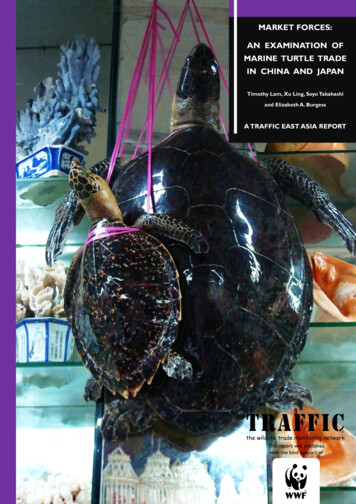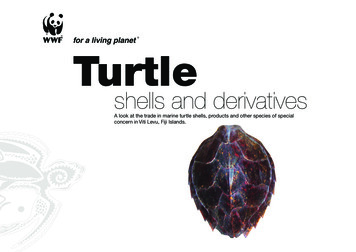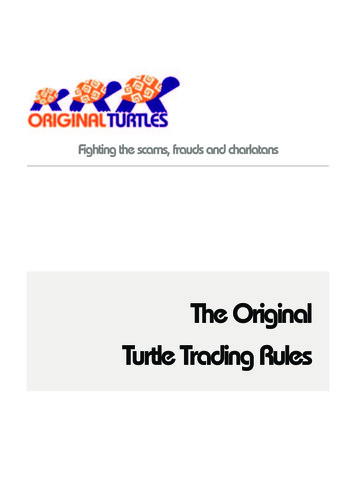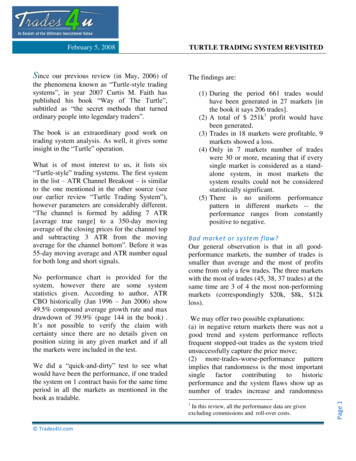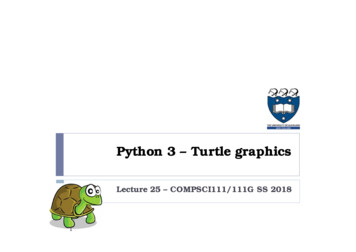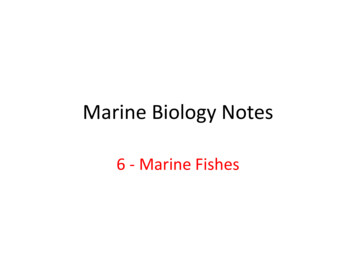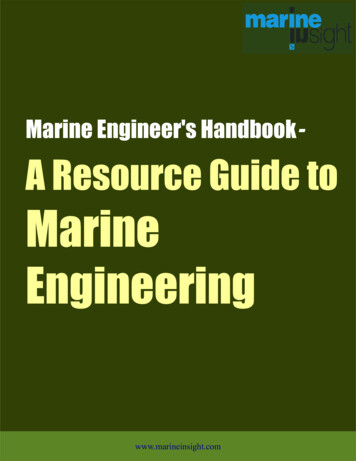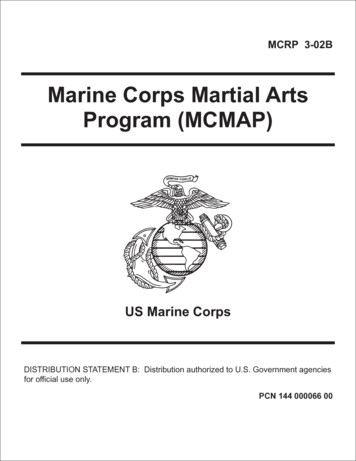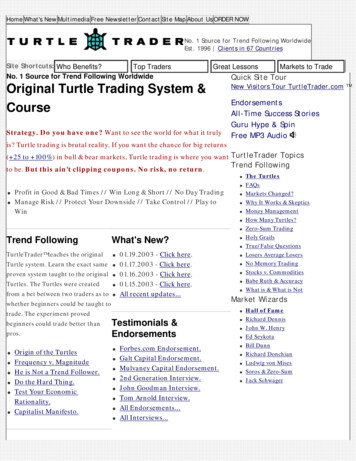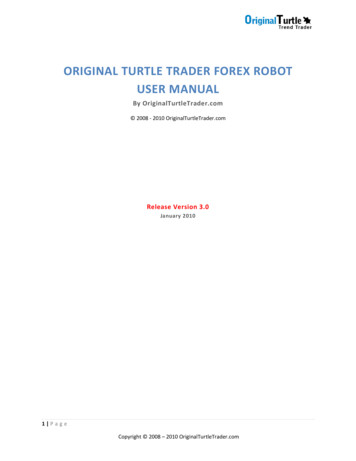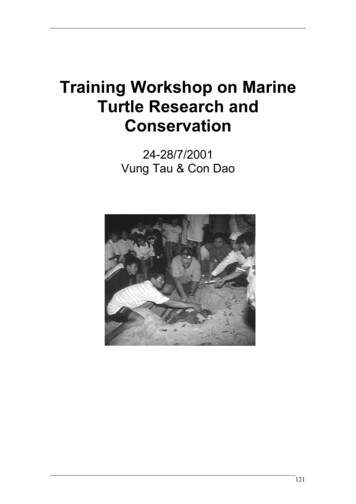
Transcription
Training Workshop on MarineTurtle Research andConservation24-28/7/2001Vung Tau & Con Dao121
122
D. V. Vu: Opening speechOPENING SPEECH: TRAINING WORKSHOP ON MARINE TURTLE RESEARCHAND CONSERVATION IN VIETNAMVu Van DaiDirector, Fisheries Department, Ministry of Fisheries, Hanoi, VietnamDear Representatives of the People’s Committee of Ba Ria – Vung Tau Province and Vung TauTown, Representatives of Branches and Offices related to Scientific Research, InternationalExperts, and Colleagues,On behalf of MoFi, I would like to welcome all representatives, scientists and managers who areattending the Training Workshop on Marine Turtle Research and Conservation in Vietnam,organized in Ba Ria - Vung Tau. The east coast of Vietnam has a tropical, monsoon climate.Back from the coast there are two large deltas, one in the North and the other in the South. Inthe middle there is a narrow delta and an enormous mountain range runs parallel with the coast.For many decades our lives have been linked with the sea; and the coastal areas of Vietnam playan important role in our country’s political, economic, diplomatic and security sectors. Vietnamalso presides over a huge area of ocean. Its seas encompass many natural ecosystems and play avery important role in our economy, and the livelihoods of many people.Vietnam is a country endowed with abundant and diverse ecosystems, and a high diversity ofspecies and gene generated resources. In general, we call these things biodiversity. According toresearch studies, there are about 12,000 plant species, 275 species of mammal, 800 species ofbirds, 180 species of reptiles, and 5,500 species of insect present in our country. Additionally,Vietnam has great potential in fisheries, with about 2040 species of sea fish, 225 species ofshrimp and more than 653 species of seaweed, 35 species of squid, 12 species of sea snake, 5species of marine turtle and 170 species of sea birds. Therefore, the Vietnamese Governmenthas been very interested in developing the fisheries sector. Moreover, we are all trying our bestto develop the available natural resources in a sustainable manner.Marine turtles have been used as food in the past (fat and protein) and to make many products(from bone, skin, fat and turtle shells). Thousands of years ago, the trading value of marineturtles was discovered. Now, however, selling marine live marine turtles, turtle meat, fat ofturtles and turtle shells is illegal. Recently, marine turtles have been used for non-consumptivepurposes such as tourism, study, scientific research, and activities related to finding jobs,gaining information, and producing incomes.The value of marine turtles is not always easy to understand, but they cannot be replacedbecause of their role in marine ecosystems. This kind of reptile is a unique part of a complicatedecosystem; its life cycle is related to other marine products (including fish and mangroveforests) as well as service of ecosystem (example: coastal zone). Due to the fact that turtlesmigrate thousands of kilometres and take more than ten years to grow up, they are a symbol ofmarine and coastal environmental health at the global level and at the regional level. Apart fromthe material value of sea turtles, these marine species also have a cultural significance that wecannot easily put a value on. Each society has its own tradition of considering turtles as asymbol of belief and knowledge. In industrial society, this kind of reptile has a special function- with an attractive appearance and an intriguing life cycle that creates much curiosity, they areideal for education and research purposes.For all these reasons, marine turtles have become a symbol of conservation locally, as well as atan international level. To protect these species and ensure the rehabilitation of their populations,large areas of the world have to be considered and managed effectively. In short, marine turtleconservation means marine and coastal area protection. It also requires that we should workTraining Workshop on Marine Turtle Research and Conservation123
hard and use strong enforcement to protect them and their natural environment - as it is the sameworld that human beings rely on.It should be highlighted that for sea turtles, and many other kinds of animals, it takes a lot ofgenerations before population sizes can be restored after declines. Moreover, when theymigrate, animals like sea turtles have to pass over the borders from this country to another.Therefore, we all share the responsibility to protect sea turtles, other animals, and their habitatsas natural heritage.Dear colleagues,It is clear that our scientific achievements in biodiversity should have to link with otherachievements of the country. The modest results that we have gained so far are a greatimprovement over the situation in past decades, and this success reflects the close, serious anduntiring cooperation not only of scientists but also of supporting groups from government andinternational organisations.Recognizing the important role of biodiversity in economy and culture, Vietnam has beenimplementing some steps to protect natural resources for some decades now. Biodiversityconservation is a big challenge for Vietnam, and protecting natural ecosystems and the speciesthat depend on them is not only a job for Vietnam; the rest of the world faces the samechallenge.I do hope that the kind attention and encouragement of the Government in combination with thevalue support of international organisations in general (and of UNDP (CMS-UNEP), DANIDA,and IUCN in particular) will help those of us who are researchers, managers and policy makersin continuing to protect Vietnam’s natural resources in a sustainable way. And that they willassist us in planning and implementing the biodiversity development action plan for the longterm benefit of the country, as well as encouraging us to display our roles as part of theinternational community that aims to protect natural heritage.We wish the training workshop the best success, and our guests good health.124
T. H. Nguyen: IUCN welcoming addressIUCN STATEMENT AND WELCOMENguyen Minh ThongCountry Representative, IUCN Vietnam, Hanoi, VietnamIt is my pleasure to be here today and to deliver a short statement on behalf of IUCN – TheWorld Conservation Union at this important Training Workshop on Marine Turtle Research andConservation in Vietnam. As you all know, Vietnam, a State Member of IUCN, ratified theConvention on Biological Diversity in November 1994. This shows the strong interest andcommitment of Vietnam to the cause of environmental protection and nature conservation.IUCN therefore, over the past years, has been in close co-operation with the Government ofVietnam, particularly the Ministry of Environment, Science and Technology/ NationalEnvironment Agency (MOSTE/NEA), in a number of activities. Special focus has been onbiodiversity conservation through, for example, our collaboration with the Ministry ofFisheries/Research Institute of Marine Products (MOFI/RIMP) in the implementation of thePilot Hon Mun Marine Protected Area.The National Training Workshop on Marine Turtle Research and Conservation in Vietnam willprovide support to the implementation of the Convention on Migratory Species Memorandumof Understanding (CMS/MoU) on Marine Turtle Conservation and Management in the IndianOcean/South-East Asia in Vietnam. This workshop will build on existing national marine turtleresearch programs to raise awareness of the CMS MoU in Vietnam, particularly amongst seniorofficials in the Ministry of Fisheries, the Forest Protection Department (terrestrial nationalparks), and the Provincial Governments. The workshop has been designed to provide acomprehensive introduction to the CMS MoU as well as an introduction to the technical skills(including field observations in Con Dao) required for officials to develop an understanding ofconservation and management issues. Additionally, the workshop will identify key stakeholdersfor participation in the development of a National Marine Turtle Action Plan for Vietnam(under the MoU), and will assess an initial set of issues for incorporation into the NationalAction Plan.Furthermore, on recommendation of the CMS Secretariat and IUCN Asia, the workshop hasprovided for limited participation by representatives of Cambodia. The reasons for this aretwofold: (1) the workshop will provide an opportunity to increase scientific exchange andcooperation between Vietnam and Cambodia. This is of particular importance given theproximity of known marine turtles distributions to the Cambodia/Vietnam border. (2) Given theabsence of a Cambodian national workshop, the present workshop will provide stimulus forCambodian participation in the MoU.This training workshop will serve as a kick-off activity within the framework of the process todevelop a draft National Action Plan for Marine Turtle Conservation and Management inVietnam, and will support Vietnam’s involvement in the CMS and regional marine turtleconservation forums. The workshop has been developed jointly by the Ministry of Fisheries(Research Institute for Marine Products), the Convention on Migratory Species Secretariat, DrPilcher of the University of Malaysia in Sarawak, and the IUCN Vietnam Marine Program. Iwould like to take this opportunity, on behalf of IUCN, to express sincere thanks all those whohave contributed to the development the workshop, especially RIMP, Prof. Dr. Pham Thuoc andhis staff the Ministry of Fisheries and others for their great support, international expert Dr.Nicholas Pilcher (University Malaysia Sarawak), Mr. Douglas Hykle (Deputy ExecutiveSecretary of CMS - UNEP), marine turtle specialist Dr. Jeff Miller, and Dr. Chan Eng Heng.Our special appreciation goes also to the CMS - UNEP, the Danish International DevelopmentAgency (Danida), the US National Marine Fisheries Service (NMFS), the US National Fish andTraining Workshop on Marine Turtle Research and Conservation125
Wildlife Foundation (NFWF), and the members of the IUCN SSC for their cooperation andgenerous provision of grants to this first national training workshop in Vietnam.Thank you, and I wish you all good health.126
D. Hykle: CMS welcoming addressCMS WELCOMING ADDRESSDouglas HykleDeputy Executive SecretaryConvention on Migratory SpeciesDirector Vu Van Dai, Distinguished Speakers, Ladies and Gentlemen,I am pleased to be with you today on this, my third or fourth visit to Vietnam, but the first tothis splendid southern coast. In February, I had the pleasure of visiting the Research Institute forMarine Products (RIMP) and the Ministry of Fisheries (MoFi), to become familiar with theirwork and to share information about the organisation that I represent, the Convention onMigratory Species (CMS).I would like to begin my remarks by paying tribute to Prof. Pham Thuoc, who had the visiontwo or three years ago to organize a national training workshop in Vietnam, as well a thepersistence to bring it to fruition with the support of the RIMP and MoFi. I would also like toacknowledge the IUCN-Vietnam office for all its work in helping to organize the meeting, andDr Nicholas Pilcher of the University of Malaysia for his efforts to raise funds for the meeting.I would like to complement the eloquent explanation of Dr Vu Van Dai of the rational for thisworkshop. I was reminded of a similar meeting that CMS organized in Africa some years ago,where some newspaper journalists were present. I remember speaking to an assistant to one ofthe journalists, who found it very amusing that we had organized a conference on marine turtleconservation. He simply couldn’t understand why 50 people from various African countries hadgathered to talk about an animal, which his compatriots consumed for food. It drove home to methe realization that we have to make a big effort to convince the general public of the rationaleand importance of our work.Marine turtles are remarkable creatures, and we will certainly learn about their characteristicstoday and during the rest of the week. They are found throughout the world, and they are valuedby different peoples and cultures for many purposes. They range from consumption for meat,eggs and shell to non-consumptive uses, such as helping to generate income for localcommunities through tourism.We know that turtles are declining in number in many parts of the world, some critically. Theirhighly migratory nature means that countries need to collaborate in order to achieve effectiveconservation. In Manila, last June, a first step was in this direction was made with theconclusion of a Memorandum of Understanding on regional collaboration among Indian Oceanand Southeast Asian countries. I am happy to announce that a representative of the Governmentof Vietnam will sign the MoU on this auspicious occasion, making Vietnam the ninth signatoryto the MoU, which will take effect on 1 September 2001.In closing, I regret very much that I will not be in a position to join you in Con Dao later in theweek, because of other pressing commitments in Bonn, but I am sure that the team of eminentexperts who have been assembled here will do a fine job of leading the discussions. I lookforward to working with you in the next days and I wish you well in your remainingdeliberations.Training Workshop on Marine Turtle Research and Conservation127
128
N. Pilcher: General biologyGENERAL BIOLOGY OF MARINE TURTLESNicolas J. PilcherInstitute of Biodiversity and Environmental ConservationUniversiti Malaysia Sarawak, 94300 Kota Samarahan, Sarawak, MalaysiaHistory and General BiologyMarine turtles have survived on earth for centuries. Mankind’s actions though, in particular inthe 19th and 20th centuries, have brought many populations to the brink of extinction.Awakened in biologists’ minds by the late Archie Carr (Carr 1942; Carr & Giovannoli 1957;Carr et al. 1966; Carr 1967; Carr 1975; Carr & Stancyk 1975; Carr 1986a; Carr 1986b), seaturtles have come to symbolise conservation efforts in a marine context, and through a farreaching and migratory group of animals such as these, widespread international co-operation.Turtles probably appeared in the late Triassic ca. 200 million years ago (Pritchard 1997). Whendinosaurs became extinct ca. 100 million years later, turtles survived through their adaptation tomarine environments, and do so today, relatively unchanged. There are several keyphysiological features that are common to all sea turtle species and which set them apart fromother Testudines, such as non-retractile limbs, extensively roofed skulls, limbs converted topaddle-like flippers, and salt glands to excrete excess salt. As is the case with other reptiles, thesex of hatchlings is dependent on temperature during incubation, particularly during the thirdand fourth weeks (Miller & Limpus 1981; Miller 1985).Today, there are seven or eight (depending on one’s point of view) extant species of sea turtles:the Leatherback Dermochelys coriacea (Family Dermochelydae), the Loggerhead Carettacaretta, the Hawksbill Eretmochelys imbricata, the Olive ridley Lepidochelys olivacea, theKemp’s ridley Lepidochelys kempi, the Green Chelonia mydas and the Flatback Natatordepressus (all in the Family Cheloniidae). An eighth species, the black turtle Chelonia agassiziiis currently the subject of debate among biologists, having first been described by Bocourt(1868) but later disputed by Bowen et al. (1993). The Convention on International Trade inEndangered Species of Flora and Fauna (CITES) lists Chelonia mydas and Caretta caretta asThreatened and the remainder are listed as Endangered, save for Natator, whose status is as yetunknown.Why Conserve Sea Turtles?Sea turtles have been used for as long as man can remember for food and other commodities.Their importance in trade dates back millennia, either for their shell, meat, oils or leather.Recently turtles have become important for non-consumptive uses such as tourism, educationand research activities, employment and other gains. A less apparent, but irreplaceable value isas an ecological resource. Turtles are unique components of complex ecological systems, theviability of which is linked to exploitable products (such as fish and shells). Turtles haveimmeasurable value as cultural assets as well as being important indicators of coastal andmarine environments. They are model flagships for both local and regional conservation, and byconserving turtles and their habitats vast marine areas have to be taken into consideration,protecting the complex, interconnected world on which human societies depend.General Reproductive BiologyIn general, turtles migrate from distant feeding grounds to different nesting areas and once themales and females arrive, they mate during a period of 1 - 2 months. After mating, females take2 - 4 weeks to emerge on the beach and lay the first clutch of eggs. After this, they may return 4Training Workshop on Marine Turtle Research and Conservation129
- 8 more times to lay again in the same season. The actual nesting process can be described inseven basic steps: Emerging - when the turtles leave the ocean and crawl up the beach; Digging- when the large body pit is excavated using the front flippers; Chambering - when the eggchamber is excavated using the rear flippers; Laying - actual egg deposition; Filling - coveringthe nest with sand back to the original beach level; Returning - crawling back down the beach tothe ocean; and Wandering - crawling over the beach between nesting attempts. Each nestcontains around 100 eggs, which measure 4 - 5 cm and weigh 20-30 g. The eggs take ca. 60days to incubate, and invariably hatch after dark, when the sand surface cools. The hatchlingsexcavate through the sand for two or three days before emerging, and weigh 20 - 25 g andmeasure 4 - 5 cm in length. Hatchlings crawl down the beach and head directly offshore usinglight, wave direction and the earth’s magnetic field for guidance. They swim for 1 - 2 days inwhat is known as a ‘swimming frenzy’ to get as far offshore as possible. After this, theygenerally float as part of the ocean’s plankton for several years until they migrate from oceanicwaters onshore to shallow feeding areas. After five to ten years they may grow to juveniles 20 40 cm in length. They remain at their feeding grounds for 5 - 10 or more years until they reachsexual maturity, and undertake their first migration to the mating and nesting areas, whereuponthe cycle is repeated (Fig. 1).Fig. 1: Generalised life cycle of marine turtles (after Lanyon et al. 1989).Individual adult female green turtles nest after 2 - 4 year intervals (remigration period), whileadult males may remigrate after 1 - 2 years (Balazs 1983). Hatchlings are believed to have asurvival probability of 0.01, but the probability of turtle survival increases exponentially withsize, where adults have the highest survival rate due to size and restricted number of predators(Crouse et al. 1987). Growth is fast (5 - 10 cm yr-1) in hatchlings and juveniles (2 - 4 cm yr-1)but very slow (0.2 cm yr-1) or non-existent in adults (Bjorndal & Bolton 1988). Sea turtles donot tend to become reproductively mature until they reach at least 20 - 50 years of age (Frazer &Ehrhart 1985).130
N. Pilcher: General biologyBy understanding the reproductive output of a population we may draw inferences on itspotential growth or decline. Although many reproductive characteristics vary from population topopulation, it is important to distinguish between evolutionary adaptations and poor nestingsuccess. For example, adult populations across the globe vary in average size and weight, andthe turtles in the Middle East region tend to be among the smallest on a global scale, with turtlesfrom the Atlantic Ocean being generally larger. Within the Indo-Pacific region, the ArabianGulf population was found to be at the lower end of the scale, while the Red Sea population wasfound to be at the upper end. Across regions, the Saudi Arabian turtles were smaller and lighterthan turtles from the Atlantic Ocean region. It is believed that the long-term feeding history ofturtles in the Arabian Gulf, with its associated environmental extremes, may have resulted in thelower overall body size. In contrast, the smaller number of turtles in the Red Sea competing forseagrass that is distributed along the extensive coast, and the lack of migrations in and out of theRed Sea, may be responsible for their larger body size. These physiological differences need notnecessarily be an indication of health; they could be simple geographical variations withinindividual species.Critical Biological AdaptationsThe physiological design and biological adaptations of sea turtles have remained unchanged formillions of years. There are certain aspects of their natural history set them apart from mostmarine inhabitants that, when combined with modern-era technology and population pressures,may prove detrimental to their long-term survival.MigrationsA characteristic that has fascinated biologists through time is the marine turtle’s periodicmigration to and from nesting and foraging sites, sometimes over vast distances. Cheloniamydas can sustain swimming speeds of 44 km·day-1 (Limpus et al. 1992) and have beenrecorded as migrating distances of up to 3410 km from Gielop (Micronesia) to Majuro(Marshall Islands) (Hirth & U.S. Fish and Wildlife Service 1997). Adult females do notnecessarily nest at the closest rookery to the feeding area, as noted with green and hawksbillpopulations along the Great Barrier Reef (Limpus et al. 1983). Through the results of taggingprojects and extensive fieldwork throughout the Caribbean (see Carr 1986b), no turtle tagged inTortuguero, Costa Rica, was found nesting elsewhere during 22 years of monitoring (Carr et al.1978), suggesting those turtles nested only at the one site. Green turtles make “very deliberatejourneys to specific geographical targets” with females showing high site fidelity afterremigrations, generally of 2 - 4 years (Limpus et al. 1992). Carr et al. (1978) reportedremigration cycles of 2 years (21 %), 3 years (49 %) and 4 years (18 %) for female greens inTortuguero. Male green turtles possibly have shorter remigration periods (Limpus 1993), andClifton (1983) described a one-year breeding cycle for the black turtle in Mexico (in Figueroa etal. 1992).Interestingly, many turtles nest only once in a lifetime (Carr et al. 1978), and are never recordedto remigrate to their nesting ground during subsequent years. With saturation field researchprojects around the globe, and given most tags last at least four or five years (Limpus 1992), itis doubtful this segment of the population would go unnoticed if they were to nest at otherrookeries. Remigrant turtles have been found to nest more frequently in a season and lay moreeggs than recruits (Carr et al. 1978), suggesting some sort of adaptive mechanism / learningprocess related to the first nesting experience. Whereas natural mortality may explain asignificant proportion of turtles that nest only once, it is suggested that a ‘bad’ nestingexperience, whereby an adult turtle is disturbed as she nests or attacked while at sea in thevicinity of the nesting beaches may also contribute to this phenomenon.Training Workshop on Marine Turtle Research and Conservation131
Age at MaturityMarine turtles are estimated to live long lives, even up to 100 years. They are known to reachsexual maturity only after 15 to 40 years, depending on species, presenting unique managementrequirements. Turtle hatchlings emerging today might only return to nest after 20 to 30 years, bywhich time few, if any, of our present scientists and managers will be following their progress.Additionally, their long absence from known feeding or foraging sites masks any changes topopulation sizes. For this reason, effects on long-term survival such as egg collection or adultharvesting might not be noted for a number of years, if at all (Fig. 2).Fig. 2: In a simple hypothetical case, if 100% of turtles were harvested each year before laying eggs, therewould reach a point at which no further breeding females would be available. However, thiswould not become apparent for another 25 years (after Mortimer 1995).Additionally, and more importantly, is that their long maturation period means that they face anever-increasing number of mortality pressures during a long period of time, which preventspopulation restocking.Habitat Requirements and DegradationSea turtles need a number of different habitats to complete their natural life cycle. From wheneggs are deposited on clean sandy beaches, to hatchling migrations through unpolluted waters,and shallow foraging sites such as seagrass beds, rocky reefs and coral reefs, to deep oceansteeming with life, turtles depend on habitats that circumscribe the tropics and even extend to farnorthern and southern latitudes. On small beaches there is a risk of density dependent nestingmortality as the population size grows exponentially (see Balazs 1980), where nests face higherrisks of being disinterred by other nesting adults with high nesting densities.Lighting on beaches is hazardous to emerging hatchlings as the lights attract hatchlings awayfrom the shoreline (Witherington & Bjorndal 1991), and in many developed coastal areas maybe responsible for a large percentage of hatchling loss. In Florida, legislation exists that controlslight use close to turtle beaches (Lutcavage et al. 1997), but this sort of regulation is not appliednor enforced in most turtle rookeries in other locations. Nesting habitats are threatened by thedisappearance of beaches through sea level rise and erosion processes (Ackerman 1997), beachnourishment, armouring and sand mining, and through residential development (Lutcavage etal. 1997).On the open sea, turtles face the risk of fishery mortality (Poiner & Harris 1994), and a numberof other threats, such as oil pollution. Hutchinson & Simmonds (1992) discuss the increasedthreats to turtles from oil as they migrate across vast expanses of ocean. At foraging sites, turtlesare threatened by marine debris (Balazs 1985), destructive fishing practices such as blast andcyanide fishing (Bjorndal 1996; Pilcher & Oakley 1997), anchors and propellers, siltation andthe use of bottom trawls in seagrass ecosystems (Bjorndal 1996).132
N. Pilcher: General biologyReferencesAckerman RA. 1997. The nest environment and the embryonic development of sea turtles. In:Lutz PL & Musick JA, eds. The biology of sea turtles. CRC Publishing, Boca Raton,pp. 83-107.Balazs GH. 1980. Synopsis of the biological data on the green turtle in the Hawaiian Islands.NMFS-SWFC-7 NOAA, Honolulu.Balazs GH. 1983. Recovery records of adult green turtles observed or originally tagged atFrench frigate Shoals, northwestern Hawaiian Islands. Tech. Memo. NMFS-SWFC-36NOAA, Honolulu.Balazs GH. 1985. Impact of ocean debris on marine turtles: Entanglement and ingestion. In:Proceedings of a workshop on the fate and impact of marine debris. NOAA, NOAATM-NMFS-SWFC-54, Honolulu, pp. 387.Bjorndal KA. 1996. Foraging ecology and nutrition of sea turtles. In: Lutz PL & Musick JA,eds. The biology of the sea turtles. CRC Press, Boca Raton, pp. 199-232.Bjorndal KA & Bolton AB. 1988. Growth rates of immature green turtles, Chelonia mydas, onfeeding grounds in the southern Bahamas. Copeia 1988: 555-564.Bocourt MM. 1868. Description de quelques cheloniens nouveau appartenent a la faunemexicaine. Ann. Sci. Nat. Ser. 5: 121-122.Bowen BW, Nelson WS & Avise JC. 1993. A Molecular Phylogeny for Marine Turtles - TraitMapping, Rate Assessment, and Conservation Relevance. Proceedings of the NationalAcademy of Sciences of the United States of America 90: 5574-5577.Carr A. 1967. Imperilled gift of the sea. National Geographic 1967: 876-890.Carr A. 1975. The Ascention Island green turtle colony. Copeia 1975 3: 547-545.Carr A. 1986a. Rips, FADS, and little loggerheads. BioScience 36: 92-100.Carr A. 1986b. The sea turtle: So excellent a fishe. University of Texas Press, Austin.Carr A & Stancyk S. 1975. Observations on the ecology and survival outlook of the hawksbillturtle. Biological Conservation 8: 161-172.Carr A, Hirth A & Ogren L. 1966. The ecology and migrations of sea turtles. 6. The hawksbillturtle in the Caribbean Sea. American Museum Novitiates 162: 1-46.Carr A, Carr MH & Meylan AB. 1978. The ecology and migrations of sea turtles. 7. The westCaribbean Sea. Bulletin of the American Museum of Natural History 162: 1-46.Carr AE. 1942. Notes on sea turtles. New England Zoological Club 21: 1-16.Carr AE & Giovannoli L. 1957. The ecology and migrations of sea turtles. 2: Results of fieldwork in Costa Rica, 1955. American Museum Novitiates 1835: 1-32.Clifton K. 1983. The ecological recovery of Chelonia agassizzi, the East Pacific turtle ofMexico. WWF-US, Mexico City.Crouse DT, Crowder LB & Caswell H. 1987. A stage-based population model for loggerheadsea turtles and implications for conservation. Ecology 68: 1412-1423.Figueroa A, Alvarado J, Hernandez F, Rodriguez G & Robles J. 1992. Population recovery ofthe sea turtles of Michoacan, Mexico: An integrated conservation approach. WWF,USFWS, Mexico City.Frazer NB & Ehrhart LM. 1985. Preliminary growth models for green, Chelonia mydas, andloggerhead, Caretta caretta, turtles in the wild. Copeia 1985: 73.Training Workshop on Marine Turtle Research and Conservation133
Hirth HF & U.S. Fish and Wildlife Service. 1997. Synopsis of the biological data on the greenturtle Chelonia mydas (Linnaeus 1758). Fish and Wildlife Service U.S. Dept. of theInterior, Washington, D.C.Hutchinson J & Simmonds M. 1992. Escalation of threats to marine turtles. Oryx 26: 95-102.Lanyon JM, Limpus CJ & Marsh H. 1989. Dugongs and turtles: Graziers in the seagrass system.In: Larkum AD, McComb A & Shepherd SA, eds. Biology of Seagrasses, A treatise onthe biology of seagras
(from bone, skin, fat and turtle shells). Thousands of years ago, the trading value of marine turtles was discovered. Now, however, selling marine live marine turtles, turtle meat, fat of turtles and turtle shells is illegal. Re
